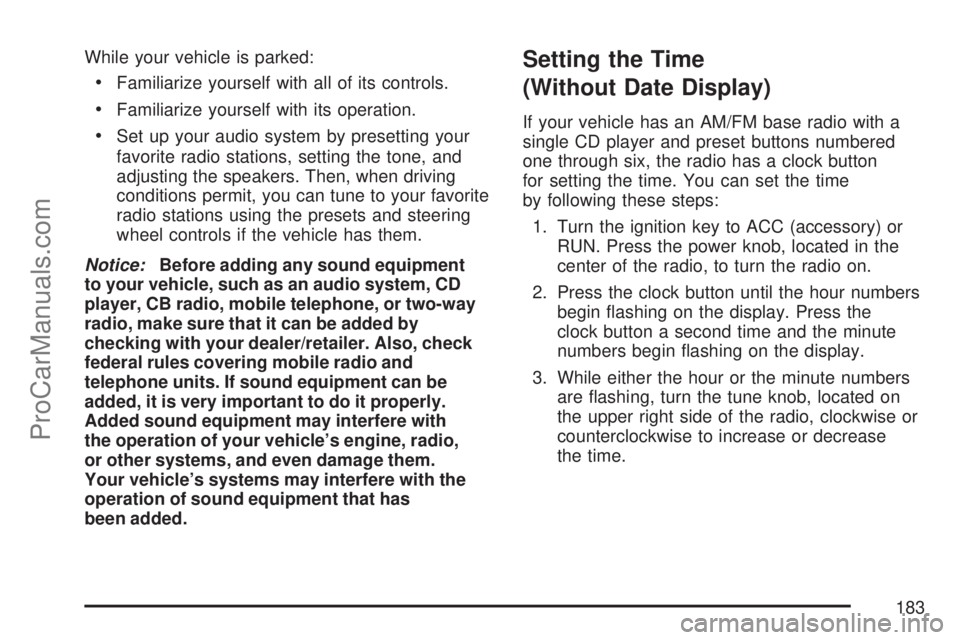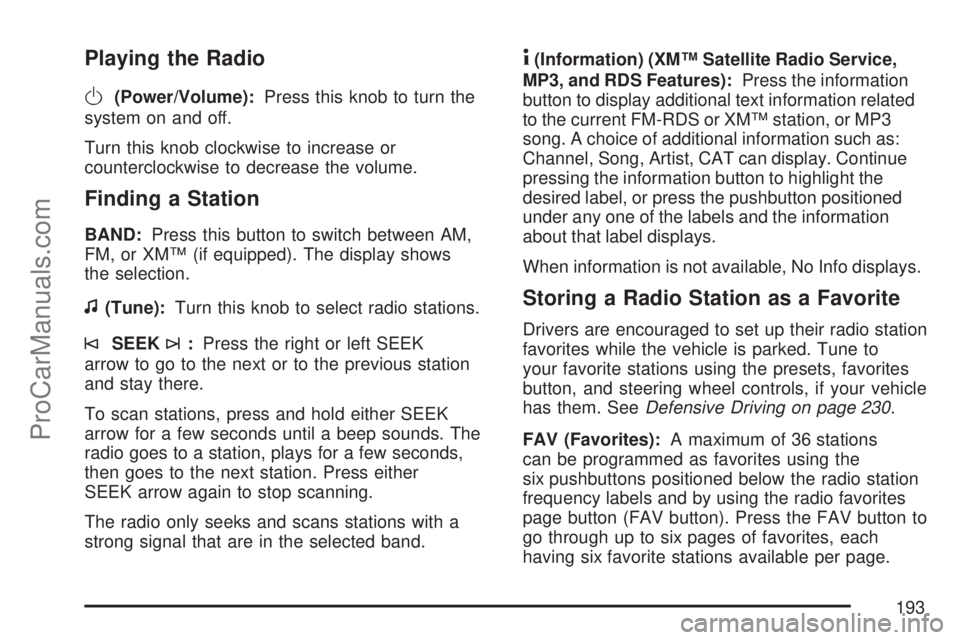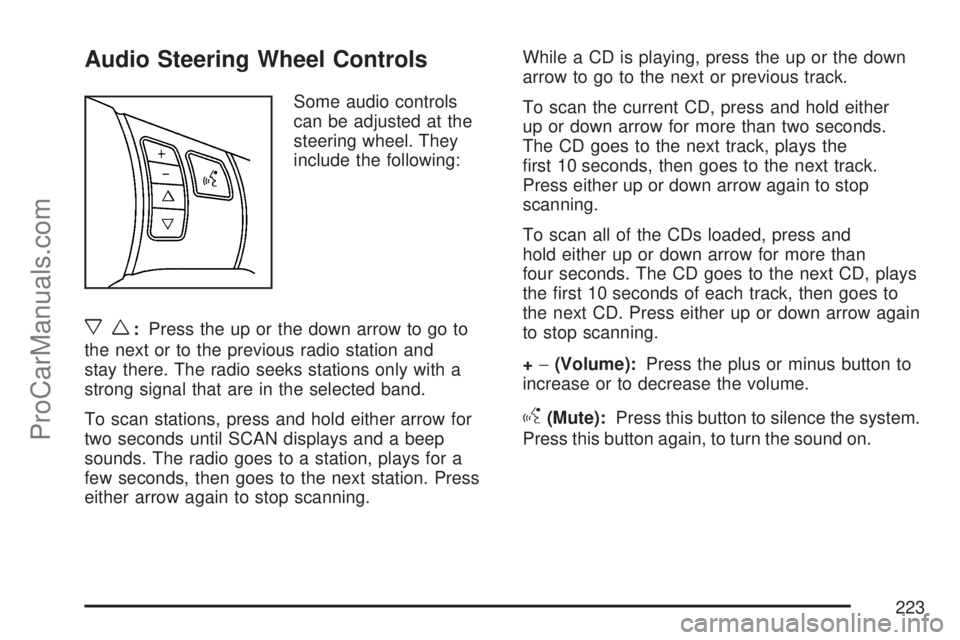wheel SATURN VUE 2007 Owner's Manual
[x] Cancel search | Manufacturer: SATURN, Model Year: 2007, Model line: VUE, Model: SATURN VUE 2007Pages: 470, PDF Size: 3.1 MB
Page 182 of 470

Audio System(s)
Determine which radio your vehicle has and then
read the pages following to familiarize yourself
with its features.
Driving without distraction is a necessity for a
safer driving experience. SeeDefensive Driving on
page 230. By taking a few moments to read this
manual and get familiar with your vehicle’s
audio system, you can use it with less effort, as
well as take advantage of its features. While your
vehicle is parked, set up your audio system by
presetting your favorite radio stations, setting the
tone and adjusting the speakers. Then, when
driving conditions permit, you can tune to
your favorite stations using the presets and
steering wheel controls if the vehicle has them.{CAUTION:
This system provides you with a far greater
access to audio stations and song listings.
Giving extended attention to entertainment
tasks while driving can cause a crash and
you or others can be injured or killed.
Always keep your eyes on the road and
your mind on the drive — avoid engaging
in extended searching while driving.
Keeping your mind on the drive is important for
safe driving. Here are some ways in which you can
help avoid distraction while driving.
182
ProCarManuals.com
Page 183 of 470

While your vehicle is parked:
Familiarize yourself with all of its controls.
Familiarize yourself with its operation.
Set up your audio system by presetting your
favorite radio stations, setting the tone, and
adjusting the speakers. Then, when driving
conditions permit, you can tune to your favorite
radio stations using the presets and steering
wheel controls if the vehicle has them.
Notice:Before adding any sound equipment
to your vehicle, such as an audio system, CD
player, CB radio, mobile telephone, or two-way
radio, make sure that it can be added by
checking with your dealer/retailer. Also, check
federal rules covering mobile radio and
telephone units. If sound equipment can be
added, it is very important to do it properly.
Added sound equipment may interfere with
the operation of your vehicle’s engine, radio,
or other systems, and even damage them.
Your vehicle’s systems may interfere with the
operation of sound equipment that has
been added.
Setting the Time
(Without Date Display)
If your vehicle has an AM/FM base radio with a
single CD player and preset buttons numbered
one through six, the radio has a clock button
for setting the time. You can set the time
by following these steps:
1. Turn the ignition key to ACC (accessory) or
RUN. Press the power knob, located in the
center of the radio, to turn the radio on.
2. Press the clock button until the hour numbers
begin �ashing on the display. Press the
clock button a second time and the minute
numbers begin �ashing on the display.
3. While either the hour or the minute numbers
are �ashing, turn the tune knob, located on
the upper right side of the radio, clockwise or
counterclockwise to increase or decrease
the time.
183
ProCarManuals.com
Page 193 of 470

Playing the Radio
O
(Power/Volume):Press this knob to turn the
system on and off.
Turn this knob clockwise to increase or
counterclockwise to decrease the volume.
Finding a Station
BAND:Press this button to switch between AM,
FM, or XM™ (if equipped). The display shows
the selection.
f(Tune):Turn this knob to select radio stations.
©SEEK¨:Press the right or left SEEK
arrow to go to the next or to the previous station
and stay there.
To scan stations, press and hold either SEEK
arrow for a few seconds until a beep sounds. The
radio goes to a station, plays for a few seconds,
then goes to the next station. Press either
SEEK arrow again to stop scanning.
The radio only seeks and scans stations with a
strong signal that are in the selected band.
4(Information) (XM™ Satellite Radio Service,
MP3, and RDS Features):Press the information
button to display additional text information related
to the current FM-RDS or XM™ station, or MP3
song. A choice of additional information such as:
Channel, Song, Artist, CAT can display. Continue
pressing the information button to highlight the
desired label, or press the pushbutton positioned
under any one of the labels and the information
about that label displays.
When information is not available, No Info displays.
Storing a Radio Station as a Favorite
Drivers are encouraged to set up their radio station
favorites while the vehicle is parked. Tune to
your favorite stations using the presets, favorites
button, and steering wheel controls, if your vehicle
has them. SeeDefensive Driving on page 230.
FAV (Favorites):A maximum of 36 stations
can be programmed as favorites using the
six pushbuttons positioned below the radio station
frequency labels and by using the radio favorites
page button (FAV button). Press the FAV button to
go through up to six pages of favorites, each
having six favorite stations available per page.
193
ProCarManuals.com
Page 223 of 470

Audio Steering Wheel Controls
Some audio controls
can be adjusted at the
steering wheel. They
include the following:
xw:Press the up or the down arrow to go to
the next or to the previous radio station and
stay there. The radio seeks stations only with a
strong signal that are in the selected band.
To scan stations, press and hold either arrow for
two seconds until SCAN displays and a beep
sounds. The radio goes to a station, plays for a
few seconds, then goes to the next station. Press
either arrow again to stop scanning.While a CD is playing, press the up or the down
arrow to go to the next or previous track.
To scan the current CD, press and hold either
up or down arrow for more than two seconds.
The CD goes to the next track, plays the
�rst 10 seconds, then goes to the next track.
Press either up or down arrow again to stop
scanning.
To scan all of the CDs loaded, press and
hold either up or down arrow for more than
four seconds. The CD goes to the next CD, plays
the �rst 10 seconds of each track, then goes to
the next CD. Press either up or down arrow again
to stop scanning.
+−(Volume):Press the plus or minus button to
increase or to decrease the volume.
g(Mute):Press this button to silence the system.
Press this button again, to turn the sound on.
223
ProCarManuals.com
Page 227 of 470

Your Driving, the Road, and
Your Vehicle............................................ 228
Driver Behavior......................................... 228
Driving Environment.................................. 229
Vehicle Design.......................................... 229
Defensive Driving...................................... 230
Drunken Driving........................................ 231
Control of a Vehicle.................................. 234
Braking...................................................... 234
Anti-Lock Brake System (ABS).................. 235
Braking in Emergencies............................. 237
Traction Control System (TCS).................. 238
All-Wheel Drive (AWD) System.................. 239
Steering.................................................... 240
Off-Road Recovery.................................... 243
Passing..................................................... 243
Loss of Control.......................................... 245
Off-Road Driving........................................ 247Driving at Night......................................... 262
Driving in Rain and on Wet Roads............ 264
City Driving............................................... 267
Freeway Driving........................................ 268
Before Leaving on a Long Trip.................. 269
Highway Hypnosis..................................... 270
Hill and Mountain Roads........................... 270
Winter Driving........................................... 272
If Your Vehicle is Stuck in Sand,
Mud, Ice, or Snow................................. 276
Rocking Your Vehicle to Get It Out........... 277
Recovery Hook.......................................... 277
Loading Your Vehicle................................ 279
Towing........................................................ 284
Towing Your Vehicle................................. 284
Recreational Vehicle Towing...................... 285
Towing a Trailer........................................ 290
Section 4 Driving Your Vehicle
227
ProCarManuals.com
Page 229 of 470

Driving Environment
You can also help avoid a rollover or other
type of crash by being prepared for driving in
inclement weather, at night, or during other times
where visibility or traction may be limited, such
as on curves, slippery roads, or hilly terrain.
Unfamiliar surroundings can also have hidden
hazards.
To help you learn more about driving in different
conditions, this section contains information
about city, freeway, and off-road driving,
as well as other hints for driving in various
weather conditions.
Vehicle Design
According to the U.S. Department of
Transportation, utility vehicles have a signi�cantly
higher rollover rate than other types of vehicles.
Utility vehicles do have higher ground clearance
and a narrower track or shorter wheelbase than
passenger cars, to make them more capable
for off-road driving. Speci�c design characteristics
like these give the driver a better view of the
road, but also give utility vehicles a higher center
of gravity than other types of vehicles. This means
that you should not expect a utility vehicle to
handle the same way a vehicle with a lower center
of gravity, like a car, would in similar situations.
But driver behavior factors are far more often
the cause of a utility vehicle rollover than are
environmental or vehicle factors. Safe driver
behavior and understanding the environment
in which you will be driving can help avoid
a rollover crash in any type of vehicle, including
utility vehicles.
229
ProCarManuals.com
Page 236 of 470

Let us say the road is wet and you are driving
safely. Suddenly, an animal jumps out in front of
you. You slam on the brakes and continue braking.
Here is what happens with ABS:
A computer senses that wheels are slowing down.
If one of the wheels is about to stop rolling, the
computer will separately work the brakes at
each wheel.ABS can change the brake pressure faster than
any driver could. The computer is programmed
to make the most of available tire and road
conditions. This can help you steer around the
obstacle while braking hard.
As you brake, the computer keeps receiving
updates on wheel speed and controls braking
pressure accordingly.
236
ProCarManuals.com
Page 237 of 470

Remember: ABS does not change the time you
need to get your foot up to the brake pedal or
always decrease stopping distance. If you get too
close to the vehicle in front of you, you will not have
time to apply the brakes if that vehicle suddenly
slows or stops. Always leave enough room up
ahead to stop, even though you have ABS.
Using ABS
Do not pump the brakes. Just hold the brake
pedal down �rmly and let anti-lock work for you.
You might feel a slight brake pedal pulsation
or notice some noise, but this is normal.
Braking in Emergencies
At some time, nearly every driver gets into a
situation that requires hard braking.
If you have ABS, you can steer and brake at the
same time. However, if you do not have ABS,
your �rst reaction — to hit the brake pedal
hard and hold it down — might be the wrong
thing to do. Your wheels can stop rolling.Once they do, the vehicle cannot respond to your
steering. Momentum will carry it in whatever
direction it was headed when the wheels stopped
rolling. That could be off the road, into the very
thing you were trying to avoid, or into traffic.
If you do not have ABS, use a “squeeze” braking
technique. This will give you maximum braking
while maintaining steering control. You can do this
by pushing on the brake pedal with steadily
increasing pressure.
In an emergency, you will probably want to
squeeze the brakes hard without locking the
wheels. If you hear or feel the wheels sliding,
ease off the brake pedal. This will help you
retain steering control. If you do have ABS, it is
different. SeeAnti-Lock Brake System (ABS)
on page 235.
In many emergencies, steering can help you more
than even the very best braking.
237
ProCarManuals.com
Page 238 of 470

Traction Control System (TCS)
Your vehicle may have a traction control system
that limits wheel spin. This is especially useful
in slippery road conditions. The system operates
only if it senses that one or both of the front wheels
are spinning or beginning to lose traction. When
this happens, the system reduces engine power to
limit wheel spin.
This light will come on
when your traction
control system is
limiting wheel spin.
SeeLow Traction Light on page 173. You may
feel or hear the system working, but this is normal.
The traction control system automatically comes
on whenever you start your vehicle. To limit
wheel spin, especially in slippery road conditions,
you should always leave the system on.But you can turn the traction control system off if
you ever need to. You should turn the system
off if your vehicle ever gets stuck in sand, mud,
ice or snow and rocking the vehicle is required.
SeeRocking Your Vehicle to Get It Out on
page 277andIf Your Vehicle is Stuck in Sand,
Mud, Ice, or Snow on page 276for more
information.
If your vehicle is
equipped with the
2.2L L4 engine, the
traction control system
can be turned off by
pressing the traction
control button.
It is located on the instrument panel above the
audio system.
If your vehicle is equipped with the 3.5L V6 engine,
the traction control system will be turned off when
the shift lever is in REVERSE (R) or LOW (L).
The traction control system warning light will be
displayed on the instrument panel. SeeTraction
Control System (TCS) Warning Light on page 172
for more information.
238
ProCarManuals.com
Page 239 of 470

The traction control system can be activated again
by pressing the traction control button for the
2.2L L4 engine, or by selecting DRIVE (D)
or INTERMEDIATE (I) for the 3.5L V6 engine.
If the system is limiting wheel spin when you press
the button, the system will not turn off until there
is no longer a current need to limit wheel spin.
You can turn the system back on at any time by
pressing the button again. If the traction control
warning light does not come on, you may not have
traction control and your vehicle should be
serviced at a retailer.
Adding non-Saturn accessories can affect your
vehicle’s performance. SeeAccessories and
Modi�cations on page 304for more information.All-Wheel Drive (AWD) System
If your vehicle has all-wheel drive (AWD), the
AWD system operates automatically without any
action required by the driver. If the front drive
wheels begin to slip, the rear wheels will
automatically begin to drive the vehicle as
required. There may be a slight engagement
noise during hard use but this is normal.
During heavy AWD applications, the engine
torque may be reduced to protect AWD system
components. If the vehicle is exposed to extended
heavy AWD usage, the AWD system will shut
itself off to protect the system from overheating.
When the system cools down, the AWD system
will activate itself again automatically; this
cool-down can take up to 20 minutes depending
on outside temperature and vehicle use.
239
ProCarManuals.com